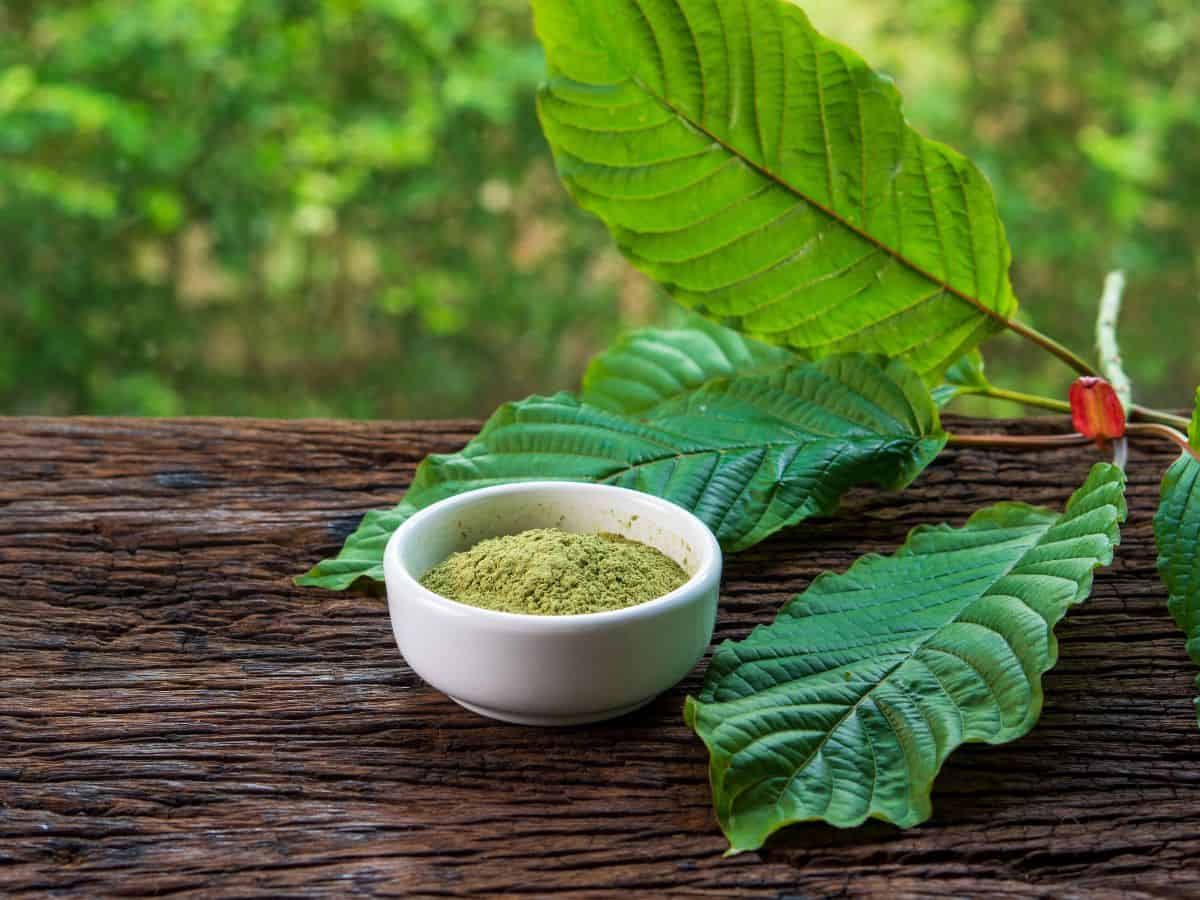While the half-life of kratom is about 24 hours, it can be detected in your body for five to six days. It can also be detected in the urine for up to a week. Kratom has become a popular medicinal herb, but some are worried about how safe or unsafe it might be.
What Is Kratom?
Kratom has been used in many South Asian countries for thousands of years. Natives have long since chewed the leaves or brewed them into tea. The leaves were often used in rituals and ceremonies due to their unique effects. Ever since the plant was introduced to the Western world, it has been growing in popularity.
You can now find kratom in various shops around the country. There are only some areas that have managed to make this substance illegal, such as Alabama, Arkansas, Rhode Island, and Vermont.
Kratom is known for its stimulant properties and ability to reduce pain. This substance’s unique feature is that it possesses opioid partial agonists.[1] Opioid agonists are what binds to the opioid receptors in your brain and reduce pain while also creating a feel-good feeling throughout the body. Opioid painkillers are also considered agonists, but they are full rather than partial agonists. This is why they produce a more prominent painkilling effect when consumed.
It may be possible to become addicted to kratom due to how it interacts with the brain’s opioid receptors. However, because they are only partial agonists, it may be more difficult to become addicted to them compared to opioid painkillers. This does not mean that this plant is without its risks. So far, the FDA has not approved the use of kratom for human use, let alone medical use.[2]
The FDA has dissuaded people from using this product, likely because not much is known about how it affects the human body. Despite the potential risk of addiction, this substance can cause some very unpleasant side effects. Some people have ended up in the hospital because of these effects.
What Does Kratom Look Like and How Is It Used?
Unprocessed kratom is nothing more than a leaf. The leaves are harvested at different times, depending on their maturity and the color of the leaf veins. Traditionally, the leaves were chewed and the juice was consumed, or the leaves were turned into tea. In more modern times, kratom manufacturers dry and crush the leaves into a fine powder. This powder is then put into capsules for oral use.
It is difficult to find kratom for sale in other forms, though it is also possible to buy kratom in powdered form without the capsule. Once the kratom is consumed, it will slowly get digested by your stomach, where it will then diffuse into your blood. Besides its mild opioid properties, kratom is also part of the coffee family and is a mild stimulant.
Many people take this substance to help them stay alert throughout the day. Others may take it to try and relieve aches and pains. Despite these benefits, kratom has various downsides that need to be acknowledged.
How Long Does Kratom Stay in Your System?
Kratom is not usually a part of drug tests, but if it happens to be, you should know that it can stay in the body for a while. For most people, it will take five to six days for the substance to be excreted from their systems. It will then no longer be detectable in your saliva or blood. It can last a bit longer in the urine, up to seven days.
Hair follicles hold onto drugs the longest. It is possible to detect kratom for up to 90 days. However, there are currently no kratom drug tests that use hair follicles. Kratom’s half-life will also differ depending on how often you use it. A 24-hour half-life is common among those who use kratom every day for more than a year. An occasional user may have a kratom half-life of a few hours.
What Are the Dangers of Kratom?
Many people who use this substance experience mild side effects, such as dizziness, headaches, and fatigue. More rarely, kratom has caused neurological symptoms in some people, such as seizures, tremors, and mental changes.[3] Others have experienced lung and heart problems, including heart palpitations and difficulty breathing. These side effects may lead to permanent damage to the affected organs.
Around a dozen people have died from using kratom. While this may not sound like a lot, it shows that kratom can potentially be dangerous for some people. It may be especially dangerous if it is mixed with other substances, such as opioid painkillers or alcohol. Besides the dangers of kratom itself, there are also risks from contaminants.
Technically, the FDA has ruled that kratom is not safe for human consumption. Some kratom companies have used this loophole to add unsafe filler ingredients to their products to cheapen the batch.
It is possible for harmful bacteria and heavy metals to be found in some batches of kratom. Consuming or even getting near some of these contaminants can cause a person to get seriously ill. There have also not been many scientific studies concerning the human use of kratom. There is no telling how this substance will affect the body in the long term.
Is Kratom Addictive?
One of the reasons why the FDA has not approved kratom for human consumption is that it may have the potential for addiction due to the way it interacts with opioid receptors in the brain. Even though it is a partial agonist, it still has the potential for substance abuse. While kratom addictions are not very common, they have happened.
Kratom addiction may also have a psychological rather than purely physical effect. Once a person gets used to using kratom every day, this may turn into an addictive habit. They may like the process of consuming kratom and may feel unsettled if this ritual is taken away from them. A psychological addiction can be just as bad as a physical one.
A person may go through withdrawals if they have to suddenly stop taking kratom after developing a kratom addiction. Kratom withdrawal symptoms include mood changes, anxiety, depression, headaches, fatigue, and nausea. Because kratom is a stimulant, a crash may follow after the consumption of this substance is stopped. The person may feel very tired for the next few days before their body makes a recovery from kratom addiction.
It takes a few weeks to get through the withdrawal symptoms. After that, the brain and body should be mostly recovered. It may be necessary to go to therapy if you often have problems with addiction.
MAKE AN APPOINTMENT
We’re here for you and can schedule an appointment 24 hours a day, 7 days a week. If the office is not open, we can refer you to one of our on call Doctors at your nearby hospital.
Frequently Asked Questions About Kratom
While kratom can be addictive, it isn’t as addictive as certain hard drugs. Heroin, for example, is infamous for being a very powerful full opioid agonist. Taking this drug creates an intense euphoria that often leads to drug addiction and may require addiction treatment. Kratom’s effects are much milder, and some don’t feel much at all when they take it.
Others, especially those with substance use disorders, may find it easier to get addicted to kratom despite its more delicate effects.
Is Taking Kratom Fatal?
In general, kratom is not fatal, though some people have died with kratom in their systems. Kratom may be fatal if you mix it with other substances, such as illegal drugs or alcohol.
Why Do People Take Kratom?
Because kratom is a stimulant with opioid-like effects, many people take it to reduce pain and increase alertness. They think that because kratom is natural, it is healthier than traditional drugs or a controlled substance. But this may not be true because of how little we know about kratom and its effects.
Who Does Kratom Show Up On Drug Tests?
According to research, kratom can be detected in urine tests for up to 9 days. The detection time can vary depending on factors such as the dosage, frequency of usage, and the individual’s metabolism. When it comes to blood tests, kratom metabolites, such as mitragynine, can be detected for several days.
It’s important to note that kratom is not typically included in standard drug tests, but there are newly developed tests that can identify its presence. Understanding the detection window of kratom is significant for individuals concerned about its withdrawal symptoms and those who may be screened for the drug. Overall, both urine and blood tests can reveal the presence of kratom in a person’s system, providing insights into their kratom usage.
What Are Kratom’s Effects on the Body?
Kratom can stay in your system for as little as five days to as long as seven days. Not much is known about how this substance affects the body, but it does have the potential for addiction and abuse, as well as harmful side effects.
Kratom, an herbal drug derived from the leaves of the kratom tree, contains various alkaloids that can have effects on the body. The specific effects of kratom can vary depending on factors such as dosage and individual physiology. When consumed, kratom alkaloids bind to opioid receptors in the brain, resulting in both stimulant and opioid-like effects. At low doses, kratom may produce increased energy, alertness, and sociability. However, at higher doses, it can have sedative and euphoric effects.
The duration of kratom’s effects on the body can vary, but the effects typically last for several hours. It’s important to note that the use of kratom has raised concerns related to substance abuse and dependence. Regular and excessive use of kratom can lead to the development of tolerance and dependence, which may result in withdrawal symptoms when discontinuing use. Kratom withdrawal symptoms can include irritability, nausea, muscle aches, insomnia, and mood disturbances.
In terms of drug testing, the detection of kratom or its metabolites in standard drug tests such as blood, urine, saliva, or hair follicle tests is unlikely, as specialized tests are required for its detection. However, it’s important to consider that kratom use may be screened for in specific circumstances, such as in forensic investigations or in specialized treatment centers.
If you have concerns about kratom use, its effects on your body, or potential interactions with medical conditions or other substances, it is recommended to consult with a medical professional or mental health professional for personalized guidance and support.
Conclusion: How Long Does Kratom Stay In Your System?
Understanding how long kratom stays in your system is essential, particularly in the context of kratom abuse, addiction, and drug testing. The duration of kratom’s presence in the body can vary based on several factors, including dosage, individual metabolism, and the type of drug test used. While kratom is not commonly included in standard drug tests such as blood or urine tests, it can be detected in specialized tests such as the 10-panel test.
The detection window for kratom in urine tests is generally up to seven days, but chronic users may have longer windows of detectability. On the other hand, blood tests can typically detect kratom for a maximum of two to three days. It’s important to note that the half-life of kratom, which is around 24 hours, means it can take approximately 5-6 days for the drug to be eliminated from the system entirely.
Considering the potential risks associated with kratom use, including withdrawal symptoms and dependence, seeking support from treatment centers and healthcare professionals is crucial. Kratom addiction should be taken seriously, and individuals struggling with addiction or withdrawal symptoms should reach out for help and guidance.
Get Help For Kratom Addiction Today
Treatment centers, like Achieve Wellness & Recovery, can provide specialized care and support tailored to address kratom addiction and promote recovery. It’s important to prioritize one’s well-being and seek professional assistance when needed to overcome kratom abuse and ensure a healthier future.
If you our someone you know needs help with their substance use issue, contact Achieve Wellness and Recovery at 833-680-0142
Sources
[1] Schimmel, J., Amioka, E., Rockhill, K., Haynes, C. M., Black, J. C., Dart, R. C., & Iwanicki, J. L. (2021). Prevalence and description of kratom (Mitragyna speciosa) use in the United States: a cross-sectional study. Addiction (Abingdon, England), 116(1), 176–181. Retrieved from https://pubmed.ncbi.nlm.nih.gov/32285981/ on 2023, May 30.
[2] Commissioner, O. of the. (n.d.-a). FDA and Kratom. U.S. Food and Drug Administration. Retrieved from https://www.fda.gov/news-events/public-health-focus/fda-and-kratom on 2023, May 30.
[3] U.S. Department of Health and Human Services. (2023h, April 24). Kratom. National Institutes of Health. Retrieved from https://nida.nih.gov/research-topics/kratom#safe on 2023, May 30.





